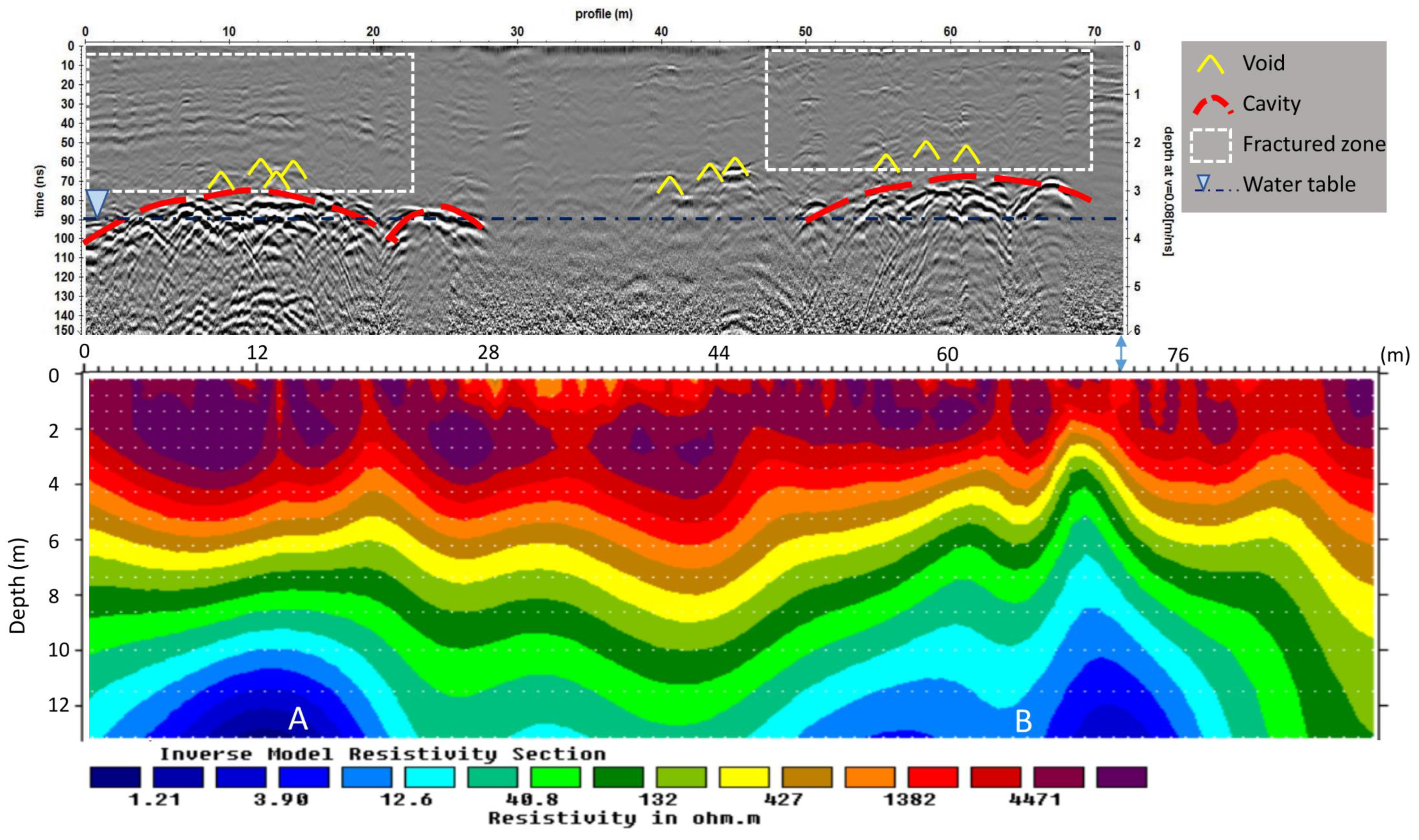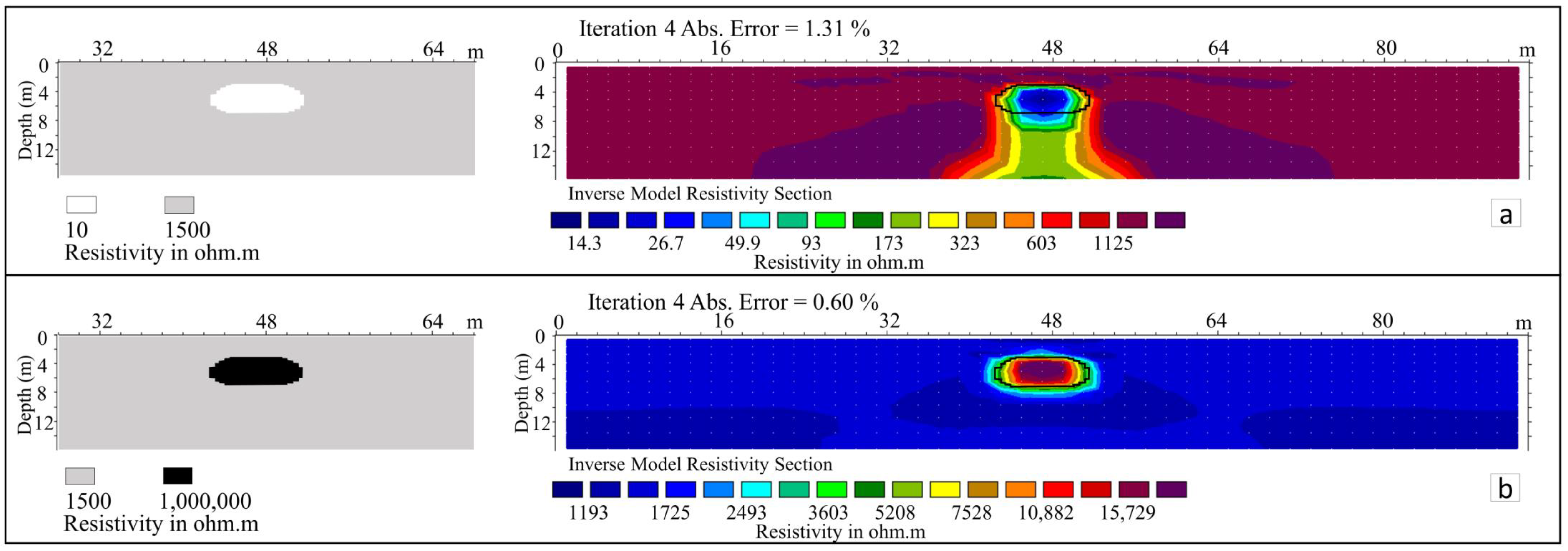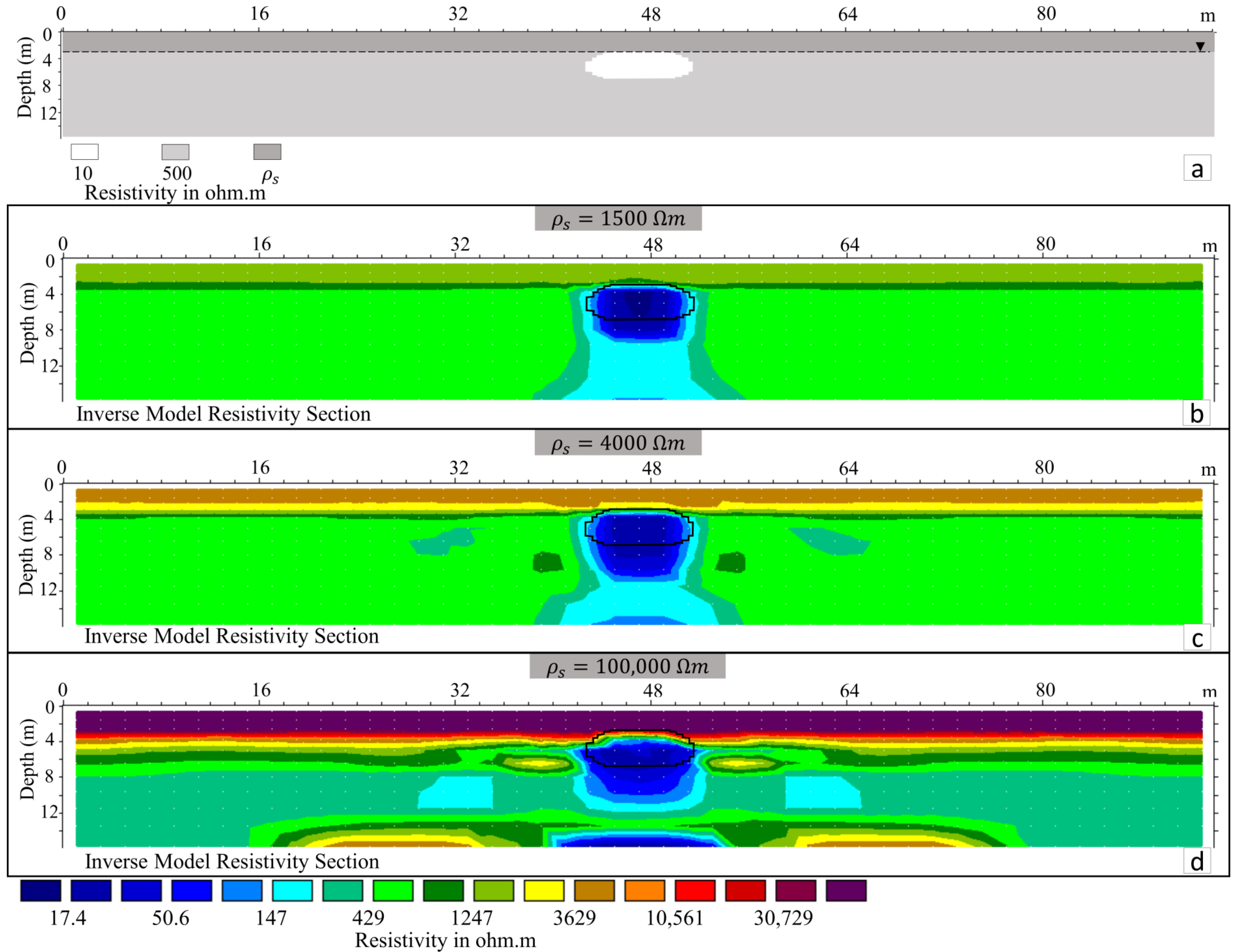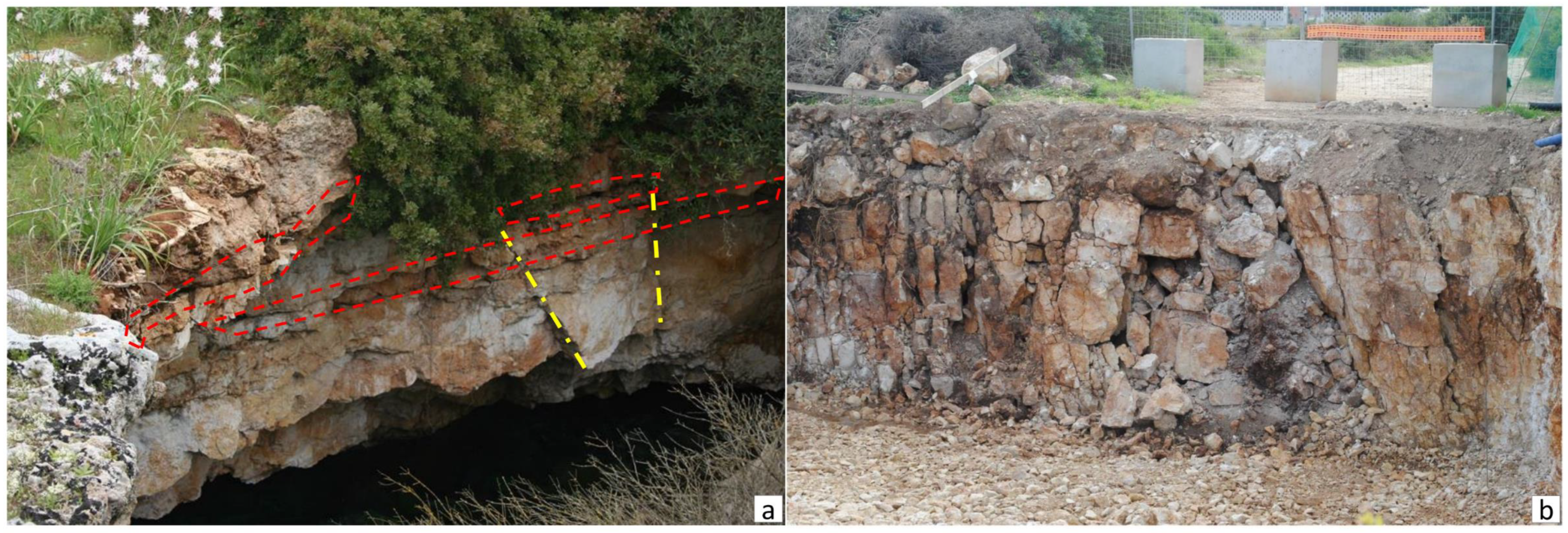Challenges in the Detection of Water-Filled Cavities in Karst Environments Using Electrical Resistivity Tomography
Abstract
1. Introduction
2. Torre Castiglione: Geological Setting
3. Methods
3.1. Ground-Penetrating Radar (GPR)
3.2. Electrical Resistivity Tomography (ERT)
3.3. Numerical Modeling
4. Results
4.1. Geophysical Survey Results
4.2. ERT Simulation Results
- -
- a resistive shallow layer;
- -
- a thin void above the cavity with different widths and at several depths.
5. Discussions
6. Conclusions
Author Contributions
Funding
Data Availability Statement
Conflicts of Interest
Abbreviations
| ERT | Electrical resistivity tomography |
| GPR | Ground-penetrating radar |
| DC | Direct current |
| TWT | Two-way travel time |
References
- Zerga, B. Karst topography: Formation, processes, characteristics, landforms, degradation and restoration: A systematic review. Watershed Ecol. Environ. 2024, 6, 252–269. [Google Scholar] [CrossRef]
- Stevanović, Z.; Gunn, J.; Goldscheider, N.; Ravbar, N. Karst: Environment and Management of Aquifers; The Ground Water Project: Guelph, ON, Canada, 2024. [Google Scholar]
- Perrotti, M.; Lollino, P.; Fazio, N.L.; Parise, M. Stability charts based on the finite element method for underground cavities in soft carbonate rocks: Validation through case-study applications. Nat. Hazard. Earth Syst. 2019, 19, 2079–2095. [Google Scholar] [CrossRef]
- Chalikakis, K.; Plagnes, V.; Guerin, R.; Valois, R.; Bosch, F.P. Contribution of geophysical methods to karst-system exploration: An overview. Hydrogeol. J. 2011, 19, 1169–1180. [Google Scholar] [CrossRef]
- Cook, K.L.; Van Nostrand, R.G. Interpretation of resistivity data over filled sinks. Geophys. Prospect. 1954, 21, 716–723. [Google Scholar] [CrossRef]
- Vincenz, A. Resistivity investigations of limestone aquifers in Jamaica. Geophysics 1968, 33, 980–994. [Google Scholar] [CrossRef]
- Dutta, N.; Bose, R.; Saikia, B. Detection of solution channels in limestone by electrical resistivity method. Geophys. Prospect. 1970, 18, 405–414. [Google Scholar] [CrossRef]
- Greenfield, R.J. Review of geophysical approaches to the detection of karst. Bull. Assoc. Eng. Geol. 1979, 16, 393–408. [Google Scholar] [CrossRef]
- Militzer, H.; Rösler, R.; Lösch, W. Theoretical and experimental investigations for cavity research with geoelectrical resistivity methods. Geophys. Prospect. 1979, 27, 640–652. [Google Scholar] [CrossRef]
- Smith, D.L. Application of the pole–dipole resistivity technique to the detection of solution cavities beneath highways. Geophysics 1986, 51, 833–837. [Google Scholar] [CrossRef]
- Barbolla, D.F.; Negri, S.; Fedi, M. Analysis of direct current resistivity data using continuous wavelet transform. Geophysics 2022, 87, E319–E334. [Google Scholar] [CrossRef]
- De Groot-Hedlin, C.; Constable, S. Occam’s inversion to generate smooth, two-dimensional models form magnetotelluric data. Geophysics 1990, 55, 1613–1624. [Google Scholar] [CrossRef]
- Li, Y.G.; Oldenburg, D.W. Approximate inverse mapping in DC resistivity problems. Geophys. J. Int. 1992, 109, 343–362. [Google Scholar] [CrossRef]
- Loke, M.H.; Barker, R.D. Rapid least-squares inversion of apparent resistivity pseudosections using a quasi-Newton method. Geophys. Prospect. 1996, 44, 131–152. [Google Scholar] [CrossRef]
- Everett, M.E. Near-Surface Applied Geophysics; Cambridge University Press: Cambridge, UK, 2013; 442p, ISBN 978-1-107-01877-8. [Google Scholar]
- Ur Rashid, M.; Ahmed, W.; Zeb, M.J.; Mahmood, Z.; Khan, S.; Waseem, M. Geoelectrical and magnetic survey of Tatta Pani thermal spring: A case study from Kotli District. Geomech. Geophys. Geo-Energy Geo-Resour. 2021, 7, 41. [Google Scholar] [CrossRef]
- Kibria, G.; Hossain, M. Investigation of geotechnical parameters affecting electrical resistivity of compacted clays. J. Geotech. Geoenviron. Eng. 2012, 138, 1520–1529. [Google Scholar] [CrossRef]
- Ozcep, F.; Yıldırım, E.; Tezel, O.; Asci, M.; Karabulut, S. Correlation between electrical resistivity and soil–water content based artificial intelligent techniques. Int. J. Phys. Sci. 2010, 5, 47–56. [Google Scholar]
- Abu-Hassanein, Z.S.; Benson, C.H.; Blotz, L.R. Electrical resistivity of compacted clays. J. Geotech. Eng. 1996, 122, 397–406. [Google Scholar] [CrossRef]
- Long, M.; Donohue, S.; L’Heureux, J.S.; Solberg, I.L.; Rønning, J.S.; Limacher, R.; O’Connor, P.; Sauvin, G.; Rømoen, M.; Lecomte, I. Relationship between electrical resistivity and basic geotechnical parameters for marine clays. Can. Geotech. J. 2012, 49, 1158–1168. [Google Scholar] [CrossRef]
- Szalai, S.; Kovács, A.; Kuslits, L.; Facskó, G.; Gribovszki, K.; Kalmár, J.; Szarka, L. Characterisation of Fractures and Fracture Zones in a Carbonate Aquifer Using Electrical Resistivity Tomography and Pricking Probe Methodes. J. Geosci. Environ. Prot. 2018, 6, 1–21. [Google Scholar] [CrossRef][Green Version]
- Satitpittakul, A.; Vachiratienchai, C.; Siripunvaraporn, W. Factors influencing cavity detection in Karst terrain on two-dimensional (2-D) direct current (DC) resistivity survey: A case study from the western part of Thailand. Eng. Geol. 2013, 152, 162–171. [Google Scholar] [CrossRef]
- Maillol, J.M.; Seguin, M.-K.; Gupta, O.P.; Akhauri, H.M.; Sen, N. Electrical resistivity tomography survey for delineating uncharted mine galleries in West Bengal, India. Geophys. Prospect. 1999, 47, 103–116. [Google Scholar] [CrossRef]
- Roth, M.J.S.; Nyquist, J.E. Evaluation of multi-electrode earth resistivity testing in karst. ASTM Geotech. Test. J. 2003, 26, 167–178. [Google Scholar] [CrossRef]
- Boucher, M.; Girard, J.-F.; Legchenko, A.; Baltassat, J.-M.; Dörfliger, N.; Chalikakis, K. Using 2D inversion of magnetic resonance soundings to locate a water-filled karst conduit. J. Hydrol. 2006, 330, 413–421. [Google Scholar] [CrossRef][Green Version]
- Zhu, J.; Currens, J.; Dinger, J. Challenges of using electrical resistivity method to locate karst conduits—A field case in the Inner Bluegrass Region, Kentucky. J. Appl. Geophys. 2011, 75, 523–530. [Google Scholar] [CrossRef]
- Putiška, R.; Nikolaj, M.; Dostál, I.; Kušnirák, D. Determination of cavities using electrical resistivity tomography. Contrib. Geophys. Geod. 2012, 42, 201–211. [Google Scholar] [CrossRef]
- Martorana, M.; Capizzi, P. Evaluation of Artifacts and Misinterpretation in 2D Electrical Resistivity Tomography Caused by Three-Dimensional Resistive Structures of Regular or Irregular Shapes. Appl. Sci. 2023, 13, 2015. [Google Scholar] [CrossRef]
- Guinea, A.; Playà, E.; Rivero, L.; Martinez, N.; Cutipa, V. Geoelectrical methods for evaluating the characteristics of different gypsum varieties in gypsum quarries. Eng. Geol. 2025, 353, 108112. [Google Scholar] [CrossRef]
- Festa, V.; Fiore, A.; Parise, M.; Siniscalchi, A. Sinkhole evolution in the Apulian karst of southern Italy: A case study, with some considerations on sinkhole hazards. J. Cave Karst Stud. 2012, 74, 137–147. [Google Scholar] [CrossRef]
- De’ Dominicis, A.; Mazzoldi, G. Interpretazione geologico-strutturale del margine orientale della Piattaforma Apula. Mem. Soc. Geol. Ital. 1987, 38, 163–176. [Google Scholar]
- de Alteriis, G.; Aiello, G. Stratigraphy and tectonics offshore of Puglia (Italy, southern Adriatic Sea). Mar. Geol. 1993, 113, 239–253. [Google Scholar] [CrossRef]
- Bosellini, A.; Morsilli, M.; Neri, C. Long-term event stratigraphy of the Apulia platform margin (Upper Jurassic to Eocene, Gargano, Southern Italy). J. Sediment. Res. 1999, 69, 1241–1252. [Google Scholar] [CrossRef]
- Johnson, K.S. Development of the Wink Sink in west Texas due to salt dissolution and collapse. In Proceedings of the 2nd Multidisciplinary Conference on Sinkholes and the Environmental Impact of Karst, Orlando, FL, USA, 9–11 February 1987; pp. 127–136. [Google Scholar]
- Tharp, T.M. Mechanics of upward propagation of cover-collapse sinkholes. Eng. Geol. 1999, 52, 23–33. [Google Scholar] [CrossRef]
- Osborne, R.A.L. Cave breakdown by vadose weathering. Int. J. Speleol. 2002, 31, 37–53. [Google Scholar] [CrossRef]
- Doglioni, C.; Mongelli, F.; Pieri, P. The Puglia uplift (SE Italy): An anomaly in the foreland of the Apenninic subduction due to buckling of a thick continental lithosphere. Tectonics 1994, 13, 1309–1321. [Google Scholar] [CrossRef]
- D'Alessandro, A.; Massari, F.; Davaud, E.; Ghibaudo, G. Pliocene–Pleistocene sequences bounded by subaerial unconformities within foramol ramp calcarenites and mixed deposits (Salento, SE Italy). Sediment. Geol. 2004, 166, 89–144. [Google Scholar] [CrossRef]
- Cigna, A.A.; Forti, P. The speleogenetic role of the air flow caused by convection. Int. J. Speleol. 1986, 15, 41–52. [Google Scholar] [CrossRef]
- White, W.B. Surface and near-surface karst landforms. In: Higgins, C.G., Coates, D.R. (Eds.), Groundwater geomorphology: The role of subsurface water in earth-surface processes and landforms. Geol. Soc. Am. Spec. Paper 1990, 252, 157–175. [Google Scholar]
- Bruno, E.; Calcaterra, D.; Parise, M. Development and morphometry of sinkholes in coastal plains of Apulia, southern Italy. Preliminary sinkhole susceptibility assessment. Eng. Geol. 2008, 99, 198–209. [Google Scholar] [CrossRef]
- Mammadova, L. Numerical modeling of groundwater flow with a focus on the salento aquifer. Ph.D. Thesis, Università del Salento, Lecce, Italy, 2025. [Google Scholar]
- Loke, M.H.; Acworth, R.; Dahlin, T. A comparison of smooth and blocky inversion methods in 2D electrical imaging surveys. Explor. Geophys. 2003, 34, 182–187. [Google Scholar] [CrossRef]
- Doyoro, Y.G.; Chang, P.-Y.; Puntu, J.M. Uncertainty of the 2D Resistivity Survey on the Subsurface Cavities. Appl. Sci. 2021, 11, 3143. [Google Scholar] [CrossRef]
- Davis, J.; Annan, A. Ground penetrating radar for high-resolution mapping of soil and rock stratigraphy. Geophys. Prospect. 1989, 37, 531–551. [Google Scholar] [CrossRef]
- Neal, A. Ground-penetrating radar and its use in sedimentology: Principles, problems and progress. Earth-Sci. Rev. 2004, 66, 261–330. [Google Scholar] [CrossRef]
- Ercoli, M.; Cirillo, D.; Pauselli, C.; Jol, H.M.; Brozzetti, F. Ground-penetrating radar signature of Quaternary faulting: A study from the Mt. Pollino region, southern Apennines, Italy. Solid. Earth 2021, 12, 2573–2596. [Google Scholar] [CrossRef]
- Venkateswarlu, B.; Tewari, V.C. Geotechnical applications of ground penetrating radar (GPR). J. Ind. Geol. Cong. 2014, 6, 35–46. [Google Scholar]
- Neal, A.; Roberts, C.L. Applications of ground-penetrating radar (GPR) to sedimentological, geomorphological and geoarchaeological studies in coastal environments. In Coastal and Estuarine Environments: Sedimentology, Geomorphology and Geoarchaeology; Geological Society of London: London, UK, 2000. [Google Scholar]
- Barbolla, D.F.; Ferrari, I.; Giuri, F.; Miccoli, I.; Scardozzi, G.; Ferrari, V.; Leucci, G. Multichannel GPR and multi-depth electromagnetic surveys for the study of Villa Eucheria and Aquinum at Castrocielo (Frosinone, Central Italy). J. Appl. Geophys. 2024, 228, 105466. [Google Scholar] [CrossRef]
- Barbolla, D.F.; Miccoli, I.; Ditaranto, I.; Scardozzi, G.; Giuri, F.; Ferrari, I.; Leucci, G. Geophysical Surveys to Highlight Buried Ancient Walls of Ugento (Lecce, Italy). NDT 2024, 2, 204–213. [Google Scholar] [CrossRef]
- Jol, H.M.; Smith, D.G. Ground penetrating radar of northern lacustrine deltas. Can. J. Earth Sci. 1991, 28, 1939–1947. [Google Scholar] [CrossRef]
- Bano, M.; Marquis, G.; Nivière, B.; Maurin, J.; Cushing, M. Investigating alluvial and tectonic features with ground-penetrating radar and analyzing diffractions patterns. J. Appl. Geophys. 2000, 43, 33–41. [Google Scholar] [CrossRef]
- Cassidy, N.J. Electrical and magnetic properties of rocks, soils and fluids. In Ground Penetrating Radar: Theory and Applications; Jol, H.M., Ed.; Elsevier: Amsterdam, The Netherlands, 2009; pp. 41–72. [Google Scholar]
- Theimer, B.D.; Nobes, D.C.; Warner, B.G. A study of the geoelectrical properties of peatlands and their influence on ground-penetrating radar surveying. Geophys. Prospect. 1994, 42, 179–209. [Google Scholar] [CrossRef]
- Sandmeier, K.J. ReflexW Version 8.1. Program for Processing of Seismic, Acoustic or Electromagnetic Reflection, Refraction and Transmission Data; Software Manual: Karlsruhe, Germany, 2016; p. 628. [Google Scholar]
- Loke, M.H. RES2DINV Version 3.45. Rapid 2-D Resistivity & IP Inversion Using the Least-Squares Method; Geotomo Software: Gelugor, Malaysia, 2000. [Google Scholar]
- Loke, M.H. RES2DMOD Version 3.03. Rapid 2D Resistivity Forward Modeling Using the Finite-Difference and Finite-Element Methods; Geotomo Software: Gelugor, Malaysia, 2016. [Google Scholar]










| Inversion Parameters | |
|---|---|
| Initial damping factor | 0.15 |
| Minimum damping factor | 0.03 |
| Value to increase damping factor | 1.05 |
| Ratio of the vertical/horizontal filter weight | 0.5 |
| Number of nodes | 4 |
| Type of forward modeling method | Finite-Difference |
| Model refinement | Model cells with normal widths |
| Ratio of thickness of first layer/unit electrode spacing | 0.34 |
| Factor to increase layer thickness with depth | 1.1 |
| Factor to increase model depth range | 1.1 |
Disclaimer/Publisher’s Note: The statements, opinions and data contained in all publications are solely those of the individual author(s) and contributor(s) and not of MDPI and/or the editor(s). MDPI and/or the editor(s) disclaim responsibility for any injury to people or property resulting from any ideas, methods, instructions or products referred to in the content. |
© 2025 by the authors. Licensee MDPI, Basel, Switzerland. This article is an open access article distributed under the terms and conditions of the Creative Commons Attribution (CC BY) license (https://creativecommons.org/licenses/by/4.0/).
Share and Cite
Negri, S.; Barbolla, D.F. Challenges in the Detection of Water-Filled Cavities in Karst Environments Using Electrical Resistivity Tomography. Geosciences 2025, 15, 349. https://doi.org/10.3390/geosciences15090349
Negri S, Barbolla DF. Challenges in the Detection of Water-Filled Cavities in Karst Environments Using Electrical Resistivity Tomography. Geosciences. 2025; 15(9):349. https://doi.org/10.3390/geosciences15090349
Chicago/Turabian StyleNegri, Sergio, and Dora Francesca Barbolla. 2025. "Challenges in the Detection of Water-Filled Cavities in Karst Environments Using Electrical Resistivity Tomography" Geosciences 15, no. 9: 349. https://doi.org/10.3390/geosciences15090349
APA StyleNegri, S., & Barbolla, D. F. (2025). Challenges in the Detection of Water-Filled Cavities in Karst Environments Using Electrical Resistivity Tomography. Geosciences, 15(9), 349. https://doi.org/10.3390/geosciences15090349






